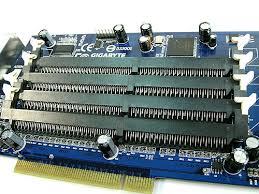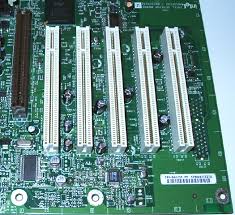Motherboards
May 30, 2009
The motherboard is the foundation upon which your PC is built.
Here’s how to buy one that can accommodate all the components you want.
The form factor sets the standard for a motherboard’s dimensions  andlayout, as well as the positioning of mounting holes, expansion slots,and ports. Your case must support the form factor of the board you choose. Most of today’s motherboards are laid out in the ATX form factor. Home theater buffs looking to build a PC for the living room should consider a smaller MicroATX board. These boards use the generalATX design but include fewer I/O slots, allowing for a shorter board that can fit in a smaller case.
andlayout, as well as the positioning of mounting holes, expansion slots,and ports. Your case must support the form factor of the board you choose. Most of today’s motherboards are laid out in the ATX form factor. Home theater buffs looking to build a PC for the living room should consider a smaller MicroATX board. These boards use the generalATX design but include fewer I/O slots, allowing for a shorter board that can fit in a smaller case.
 Your most important decision when buying a motherboard is the processor family you want the board to support. AMD’s various CPUs are compatible with Sockets 754, 939, 940, AM2, and AM2+, depending on the particular subfamily. The socket number, in the first three cases, simply corresponds to the number of pins found on the bottom of the processor; the AM2 and AM2+ sockets, the latest iterations, use 940 pins and work with DDR2 SDRAM. Sockets 478 and LGA775 support Intel Pentium 4, Celeron, Core 2 Duo, Core 2 Quad, and Core 2 Extreme processors, the only difference being that the LGA775 design has the pins located on the motherboard CPU socket, as opposed to on the CPU itself. Intel also recently released LGA1366, which is designed for its newer and larger Core i7 processors, and thus won’t work with LGA775 CPUs.
Your most important decision when buying a motherboard is the processor family you want the board to support. AMD’s various CPUs are compatible with Sockets 754, 939, 940, AM2, and AM2+, depending on the particular subfamily. The socket number, in the first three cases, simply corresponds to the number of pins found on the bottom of the processor; the AM2 and AM2+ sockets, the latest iterations, use 940 pins and work with DDR2 SDRAM. Sockets 478 and LGA775 support Intel Pentium 4, Celeron, Core 2 Duo, Core 2 Quad, and Core 2 Extreme processors, the only difference being that the LGA775 design has the pins located on the motherboard CPU socket, as opposed to on the CPU itself. Intel also recently released LGA1366, which is designed for its newer and larger Core i7 processors, and thus won’t work with LGA775 CPUs.
Most motherboards feature two to six memory slots. (Because of their size,
MicroATX boards tend to offer fewer slots than their ATX counterparts.)
 Regardless of the board you choose, make sure it has enough slots to accommodate your needs. Most current motherboards use the DDR2 memory standard, though boards that support faster DDR3 memory (especially for use with Intel’s Core i7 CPUs) are becoming increasingly popular as well—seek them out if you’re looking for optimum performance and enhanced future expandability.
Regardless of the board you choose, make sure it has enough slots to accommodate your needs. Most current motherboards use the DDR2 memory standard, though boards that support faster DDR3 memory (especially for use with Intel’s Core i7 CPUs) are becoming increasingly popular as well—seek them out if you’re looking for optimum performance and enhanced future expandability.
Most new motherboards offer multiple Serial ATA connectors and a single IDE connector, allowing you to connect both newer and older hard drives and optical drives. If you expect a need for more than two IDE drives, make sure your motherboard has multiple IDE connectors.
Most ATX motherboards provide at least four PCI slots for expansion. While these standard PCI slots are usually present for expansion cards like
sound cards and Ethernet cards, faster PCI Express (PCIe) slots are
also common features on mainstream boards. PCIe slots differ among
 themselves, however, according to the number of links, or lanes, they support. For instance, a PCIe x16 slot provides greater bandwidth than a PCIe x1 slot. (A single lane can transmit 2.5Gbps in each direction.) As a result, PCIe graphics cards employ x16, whereas an Ethernet card
themselves, however, according to the number of links, or lanes, they support. For instance, a PCIe x16 slot provides greater bandwidth than a PCIe x1 slot. (A single lane can transmit 2.5Gbps in each direction.) As a result, PCIe graphics cards employ x16, whereas an Ethernet card
might use x1. Any expansion cards you plan to use must be compatible with the specific slot types, of course. (One exception: Cards designed or the newer PCIe 2.0 standard will work in older PCIe slots.)
It’s possible to squeeze even more performance out of your system with a process known as overclocking, which forces your components to run at faster speeds than the manufacturer originally designated. If you’re a compulsive tweaker, you’ll want to look for a motherboard with features in the BIOS that let you adjust the frequency of your front-side bus, or FSB, so your system will run faster than it would out of the box. Most high-performance (and high-cost) systems and motherboards support this
the BIOS that let you adjust the frequency of your front-side bus, or FSB, so your system will run faster than it would out of the box. Most high-performance (and high-cost) systems and motherboards support this
process; some companies even offer overclocking as a check-out option.
One word of warning: Overclocking can cause serious system instability,
especially if your computer isn’t cooled well enough—if you’re not sure
about what you’re doing, or if you don’t have enough fans installed,
you’re better off leaving the settings as they are.
Tags: Motherboards
Powered by Computer 2000
